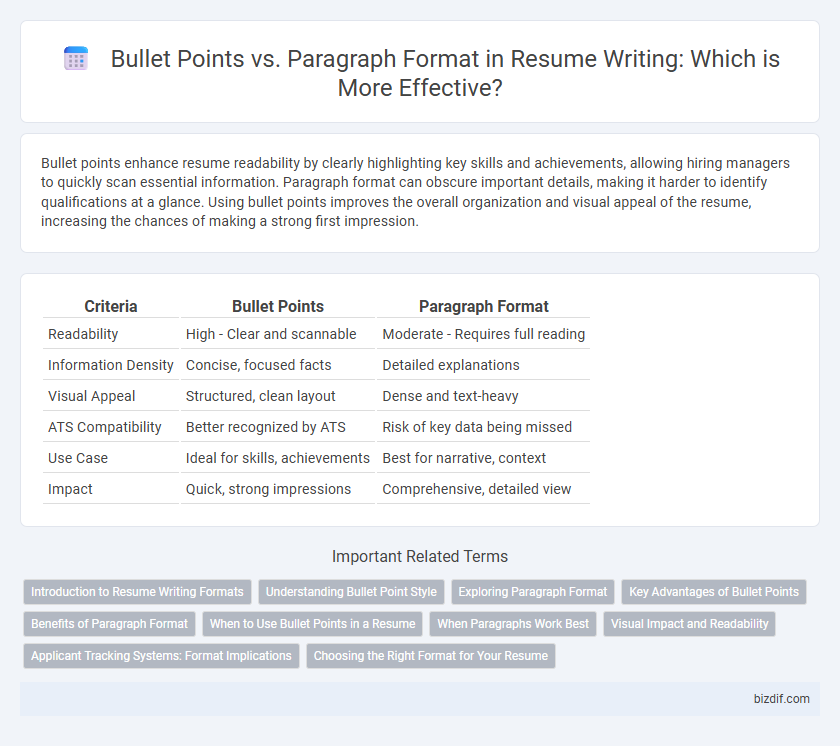Bullet points enhance resume readability by clearly highlighting key skills and achievements, allowing hiring managers to quickly scan essential information. Paragraph format can obscure important details, making it harder to identify qualifications at a glance. Using bullet points improves the overall organization and visual appeal of the resume, increasing the chances of making a strong first impression.
Table of Comparison
| Criteria | Bullet Points | Paragraph Format |
|---|---|---|
| Readability | High - Clear and scannable | Moderate - Requires full reading |
| Information Density | Concise, focused facts | Detailed explanations |
| Visual Appeal | Structured, clean layout | Dense and text-heavy |
| ATS Compatibility | Better recognized by ATS | Risk of key data being missed |
| Use Case | Ideal for skills, achievements | Best for narrative, context |
| Impact | Quick, strong impressions | Comprehensive, detailed view |
Introduction to Resume Writing Formats
Bullet points and paragraph formats serve distinct purposes in resume writing; bullet points enhance readability by succinctly highlighting key achievements and skills, while paragraph format offers a narrative style ideal for summarizing professional profiles. Recruiters often prefer bullet points for their ability to quickly convey essential qualifications and experiences, increasing the chances of passing applicant tracking systems (ATS). Selecting the appropriate format depends on the job role and the candidate's career stage, with bullet points favored for technical and performance-driven positions and paragraphs suitable for storytelling in creative or leadership roles.
Understanding Bullet Point Style
Bullet point style in resume writing enhances readability by clearly highlighting key skills and achievements, allowing recruiters to quickly scan and grasp essential information. This format emphasizes conciseness and action-oriented language, often starting with strong verbs to demonstrate impact. Using bullet points effectively organizes content, making qualifications stand out compared to dense paragraph formats.
Exploring Paragraph Format
Paragraph format in resume writing provides a narrative flow that effectively conveys detailed information about job responsibilities and achievements. It allows for a more nuanced explanation of skills, context, and impact, making it ideal for roles requiring complex problem-solving or leadership. This format enhances storytelling by connecting experiences and highlighting comprehensive professional growth without the abrupt breaks of bullet points.
Key Advantages of Bullet Points
Bullet points enhance readability by breaking down information into concise, easily scannable segments that highlight key achievements and skills. They improve the visual appeal of a resume, making it quicker for hiring managers to identify relevant qualifications and accomplishments. Bullet points also allow for precise, action-oriented language that clearly communicates responsibilities and results.
Benefits of Paragraph Format
Paragraph format in resume writing offers a cohesive narrative that clearly outlines skills and experiences in a fluid, easy-to-read manner. This format allows candidates to showcase their professional story with context and depth, enhancing the understanding of their qualifications for hiring managers. Using paragraphs can also emphasize communication skills and create a more personalized impression compared to bullet points.
When to Use Bullet Points in a Resume
Bullet points are ideal for resumes when highlighting specific skills, achievements, and quantifiable results to improve readability and emphasize key information. Use bullet points to break down complex job responsibilities or accomplishments into concise, easy-to-scan statements that capture hiring managers' attention. This format works best for roles requiring measurable outcomes, technical expertise, or when listing multiple relevant qualifications.
When Paragraphs Work Best
Paragraph format works best in resumes when describing complex job roles or achievements that require detailed explanations and storytelling to convey context effectively. This format allows for a more fluid narrative, providing recruiters with a deeper understanding of soft skills, leadership experiences, and project impacts. Using paragraphs is ideal for senior-level professionals and career changers who need to highlight strategic thinking and nuanced responsibilities.
Visual Impact and Readability
Bullet points enhance visual impact by breaking information into concise, easily scannable segments, improving readability for hiring managers. Paragraph format can appear dense and overwhelming, potentially causing key achievements to be overlooked. Utilizing bullet points ensures critical skills and accomplishments stand out effectively, increasing the resume's overall clarity and engagement.
Applicant Tracking Systems: Format Implications
Applicant Tracking Systems (ATS) favor bullet points over paragraphs as they improve keyword recognition and readability, enhancing the chances of passing initial resume screenings. Bullet points clearly separate skills and achievements, making it easier for ATS algorithms to parse relevant information efficiently. Paragraph formats often cause ATS parsing errors, leading to missed keywords and lower ranking in candidate shortlists.
Choosing the Right Format for Your Resume
Bullet points enhance readability by highlighting key achievements and skills, making it easier for recruiters to scan your resume quickly. Paragraph format works well for summarizing experience or providing context, but may dilute the impact of individual accomplishments. Selecting the right format depends on the job role and the need for clarity versus detailed narrative in presenting your qualifications.
Bullet points vs Paragraph format Infographic

 bizdif.com
bizdif.com